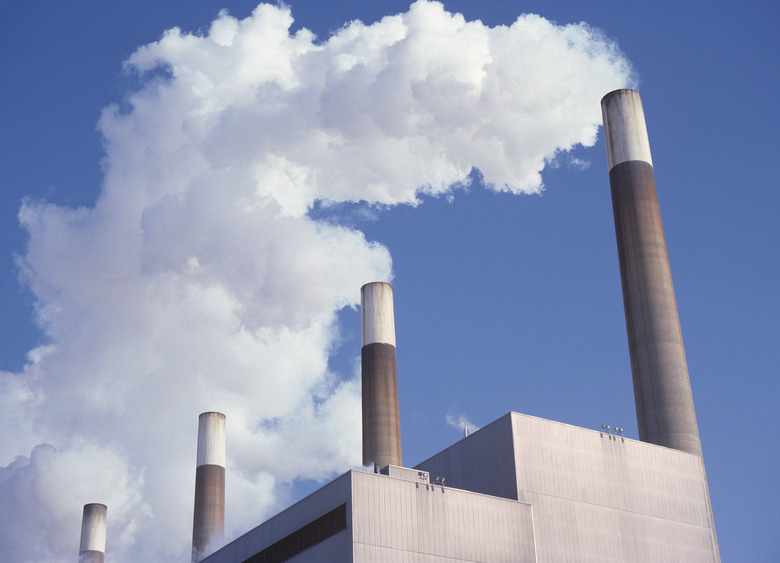What Are Smoke Stacks?
At one time, nearly every house, business and factory had at least one chimney or smokestack spewing out a stream of smoke. When homes were spread out and factories were small, the smoke might not have seemed like a real concern. As populations and factories grew, however, the effect of all those smoking chimneys became much more apparent.
Smokestack Definition
Smokestack Definition
Smokestacks are large, chimneylike pipes that allow smoke and gases to escape buildings. The first use of the term smokestack appeared in 1836, early in the Industrial Revolution. While smokestack may be written as two words ("smoke stack"), the compound word smokestack is the preferred spelling. The term chimneystack refers to the part of the chimney above the roof.
Although chimney is another word for smokestack, generally people use chimney when referring to the flue on homes, and smokestack when referring to commercial factory or power plant chimneys.
Smokestack Design
Smokestack Design
Smokestack designs must be tall enough to release gases and smoke above the local inversion layer. The smoke then rises and blows away rather than settling into the immediate area. Surface inversions occur, usually at night, when cold ground chills the air directly above, and the heavier cold air stays in place. Night inversions may be a few hundred feet thick, so smokestacks must be designed to be taller than the local conditions.
Because the smoke needs to rise, rain covers may not be allowed. Designers must also consider how surrounding buildings or natural features may impact the flow of released gases and smoke.
Modern stacks may have electrostatic precipitators installed to capture particulate matter (ash and soot) to reduce air pollution. These precipitators use two electrodes. The first electrode causes the soot or ash to develop a negative charge. The second electrode has a strong positive charge that attracts and holds the particles. Electrostatic precipitators vary, depending on the type of soot and ash traveling through the smokestack.
Air traffic requires an additional safety consideration for smokestacks: They must have lights to warn aircraft. Depending on the area, power plant and factory smokestacks may be over 900 feet tall.
Smokestack Smoke and Air Pollution
Smokestack Smoke and Air Pollution
In general, outdoor air pollution includes fine particles, noxious gases and ground-level ozone. Fine particles come from burning fuels such as wood, oil, natural gas, gasoline and coal. Noxious gases include sulfur dioxide, nitrogen oxides, carbon dioxide, carbon monoxide and chemical vapors. Ground-level ozone results from urban smog reacting in sunlight.
Power plants burning fossil fuels, especially coal, require smokestacks to release the smoke and gases generated during burning. Taller smokestacks reduce the impact of pollutants on the local area by spreading the released pollutants over a larger area.
Pollutants from burning coal vary based on the chemistry of the coal, but in general, burning coal releases carbon dioxide, carbon monoxide, sulfur dioxide, nitrogen oxides, mercury, arsenic and benzene. About 40 percent of the world's electricity comes from coal-burning plants. South Africa generates about 94 percent of its electricity by burning coal while India and China generate 70 to 75 percent of their electricity by burning coal.
Coal Generators and Air Pollution
Coal Generators and Air Pollution
The Environmental Protection Agency requires that coal-generating power plants have their smokestack emissions checked annually by an independent auditor. Despite this testing, air pollution from power-generating plants causes approximately 52,000 premature deaths in the U.S., according to a 2013 MIT study, with a higher number of deaths occurring in the eastern U.S. where coal has a higher sulfur content. Coal-generated air pollution released through smokestacks historically have had similarly deadly consequences.
In December of 1952, the combined smoke from burning coal released from London's home chimneys and factory smokestacks became especially thick. An unexpected temperature inversion trapped the smoke. The sulfur oxides in the smoke reacted with water vapor in fog to form sulfuric acid droplets. These droplets especially impacted those with existing lung conditions.
London's Great Smog of 1952 directly and indirectly caused the deaths of an estimated 12,000 people. In addition, a recent study of children who were under one year old or whose mothers were pregnant during the Great Smog found an approximately 20 percent higher incidence of asthma.
References
- Vermont State Colleges: Tall and Short Smoke Stacks
- Washington State Legislature: Obstruction Lighting Standards – Smokestacks and Similar Obstructions
- Vocabulary.com: Smokestack
- Merriam-Webster Dictionary: Smokestack
- University of Calgary: Energy Education: Coal Fired Power Plant
- University of Calgary: Energy Education: Electrostatic Precipitator
- NIH National Institute of Environmental Health Sciences: Air Pollution
- History of Massachusetts Blog: Industrial Revolution Timeline
- Vermont Department of Environmental Conservation: Stack Height and Rain Guard Guidance
- The Center for Public Integrity: EPA Wants to Limit Pollution From Tall Smokestacks
- MIT News: Air Pollution Causes 200,000 Early Deaths Each Year in the U.S.
- Environment and Society Portal: The Great Smog of London
- National Weather Service Bureau of Meteorology: Fundamentals of Aviation Meteorology Course Notes
Cite This Article
MLA
Blaettler, Karen G. "What Are Smoke Stacks?" sciencing.com, https://www.sciencing.com/info-8068108-smoke-stacks/. 22 November 2019.
APA
Blaettler, Karen G. (2019, November 22). What Are Smoke Stacks?. sciencing.com. Retrieved from https://www.sciencing.com/info-8068108-smoke-stacks/
Chicago
Blaettler, Karen G. What Are Smoke Stacks? last modified March 24, 2022. https://www.sciencing.com/info-8068108-smoke-stacks/
